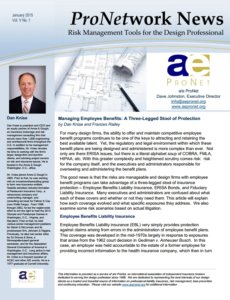 In the world of claims-related contract clauses for design professional agreements, the indemnity and defense clauses get all the attention. However, lurking in the shadow of the indemnity clause is a menacing cousin with potentially even greater and more frequent impact and risk: the prevailing party attorneys’ fee clause. Both clauses share the common risk that they are often not covered by professional liability insurance because each represents a contractually-assumed liability which would not exist in the absence of the contract.
In the world of claims-related contract clauses for design professional agreements, the indemnity and defense clauses get all the attention. However, lurking in the shadow of the indemnity clause is a menacing cousin with potentially even greater and more frequent impact and risk: the prevailing party attorneys’ fee clause. Both clauses share the common risk that they are often not covered by professional liability insurance because each represents a contractually-assumed liability which would not exist in the absence of the contract.
The indemnity clause draws the far greater attention because that obligation and exposure often arises during the claim by way of the defense obligation, as opposed to the attorneys’ fees clause which ultimately comes into play definitively only after a final judgment. Moreover, many design professionals (and especially their CFOs) are attracted to the prevailing fees clause as a means of effectively collecting unpaid fees. Without such a clause, they worry that the expense of pursuing collection of unpaid fees will eat up much of the ultimate recovery. Accordingly, it has some initial positive appeal.
However, that appeal is limited in perspective and overlooks the far greater potential negative impact of the prevailing party attorneys’ fees clause in the context of a professional liability claim which is the all too common response to even justified actions to recover unpaid fees. As opposed to the indemnity and defense obligation, the prevailing party attorneys’ fees clause will apply far more frequently. The indemnity and defense clause applies only where the client itself is facing a third-party claim. By contrast, the prevailing party attorneys’ fees clause will generally apply to every client dispute, regardless if third parties are involved. Since the majority of claims against design professionals come from the project client, that makes it far more likely and relevant. Moreover, where professional liability issues are involved in the dispute, the presence of the clause may actually dilute the design professional’s fiscal advantage. Specifically, absent the perceived panacea of the prevailing party attorneys’ fees clause, design professionals frequently hold a superior financial advantage during claims by virtue of their insurance which will fund defense costs as compared to the client claimant which is often left to fund the costs of litigation from their own resources. The unfortunate reality is that pacified by the promise or potential to recover their attorneys’ fees at the end of the dispute, many client claimants and their attorneys incur far more than they would absent that prospective reimbursement—even to the point of incurring multiples in expense beyond the prospective recovery. Even if the claim is largely defeated or reduced, even a minimal net recovery may establish the client as the prevailing party entitled to recover the attorneys’ fees incurred in the action.
Whether expressly stated as such, or not, it is important to recognize that a prevailing party attorneys’ fees clause is almost always a two edged sword equally available to both parties. As a matter of consumer protection, nearly every state has statutes which refuse to recognize one-sided attorneys’ fees clauses and automatically convert the clause into a bilateral clause entitling and exposing each side to the benefits and burdens of the clause. (See for example Oregon Revised Statute 20.096 and Florida Statute Section 57.105(7).) Accordingly, a clause which purports to entitle the design professional to recovery of its attorneys’ fees in pursuit of its fees will most often to create and equivalent right of recovery in the client for contract related claim.
Whether proposed by the client or by the design professional, prevailing party attorneys’ fees clauses are a common component of many commercial contracts, including design professional service agreements. An unqualified prevailing party attorneys’ fees clause is almost never a good idea for a design professional. Where such a clause is proposed, the following five options present a descending structure of preferred approaches. In proposing or negotiating any of these five options, frequently the best rationale in support of these approaches is that any dispute should focus on resolution of the dispute and not arming the lawyers for battle.
This has been an excerpt of the March 2015 issue of ProNetwork News, titled Prevailing Party Perils: Attorney’s Fees’ Clauses in Professional Service Contracts. To continue reading about the five preferred approaches to dealing with an unqualified prevailing party attorneys’ fees clause, click here to download the full PDF version of our newsletter for free.
About the Author
David A. Ericksen is a principal shareholder in and immediate past President of the law firm of Severson & Werson in San Francisco, California, and leads the firm’s Construction and Environmental Practices. For over twenty years, Mr. Ericksen has specialized in the representation of architects, engineers, construction managers, design-builders, and other construction professionals. Mr. Ericksen’s expertise covers all aspects of such professional practice as lead litigation and trial counsel, as well as being an active resource for risk management, strategic planning, and transactional matters. He is a trusted and valued resource to design and construction professionals and their insurance carriers across the United States and beyond. He has been repeatedly recognized as an industry leader, including being named a Construction “SuperLawyer” for the last eight years. He is a graduate of Boalt Hall School of Law, University of California, Berkeley, a former law clerk to the Washington State Supreme Court, and a member of and resource to numerous construction and environmentally-related professional organizations. Mr. Ericksen is a frequent speaker before construction professional organizations such as the AIA, SEA, ACEC, CSI and others, as well as providing in-house training seminars for firms.








